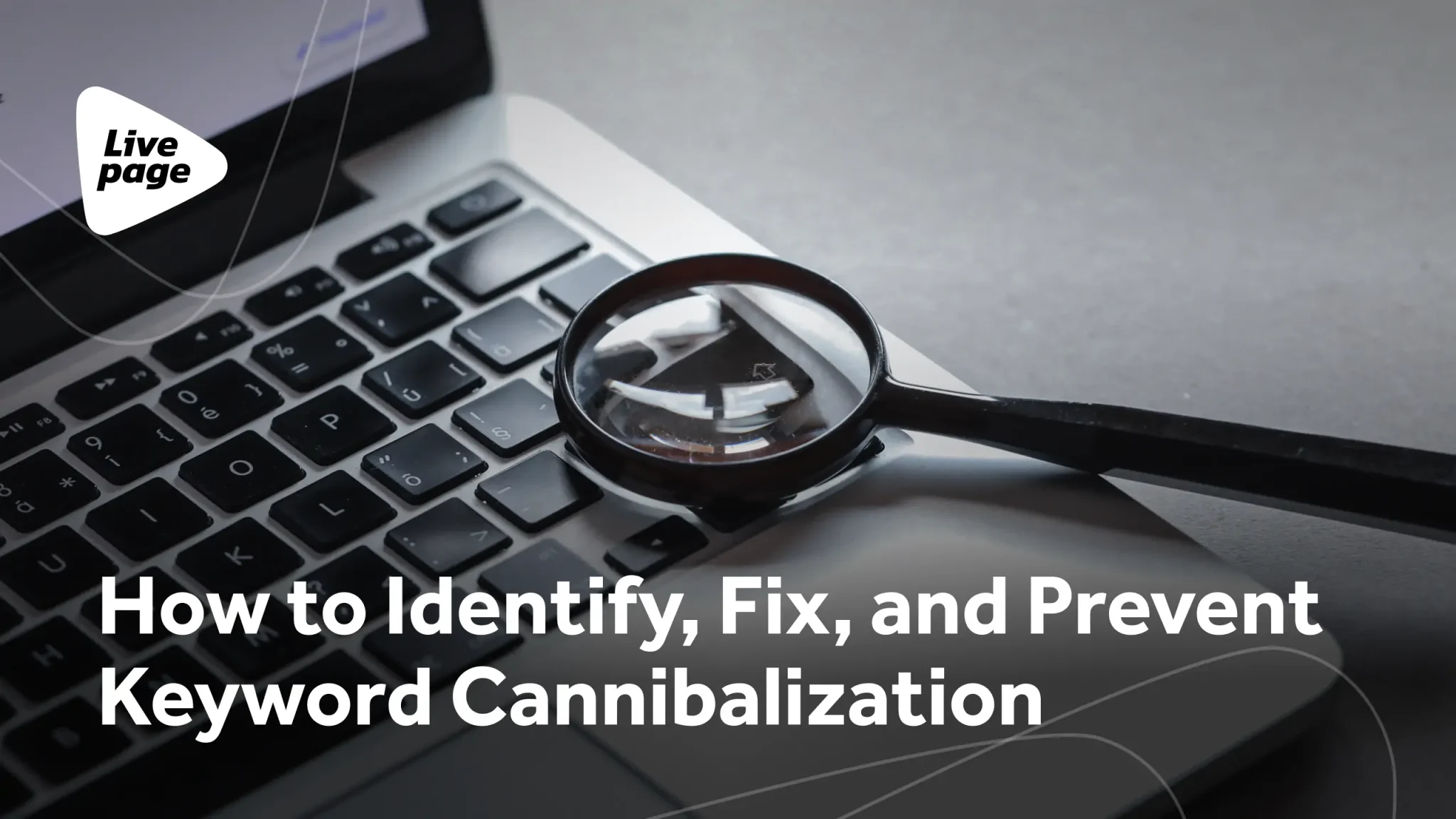
How to Identify, Fix, and Prevent Keyword Cannibalization to Improve Your Website’s SEO

Are you still adding all your target keywords to a single page and wondering why your rankings aren’t improving? Is your SEO team suggesting you write multiple articles targeting the same customer query? Today, we will explain the concept of keyword cannibalization and how to effectively promote your website to avoid the need for its revision.
Read our article to learn about:
- What is keyword cannibalization?
- Does keyword cannibalization harm your website?
- How to identify cannibalized keywords on your website?
- How to resolve keyword cannibalization?
- What mistakes to avoid when fixing keyword cannibalization?
What is keyword cannibalization?
It is generally believed that keyword cannibalization harms the ranking of two pages since Google struggles to determine which page to rank higher, resulting in decreased positions for both. But does the presence of similar keywords on multiple pages always harm a website?
Keyword cannibalization occurs when a website has multiple pages optimized for the same cluster of keywords. These pages start competing with each other, resulting in decreased ranking for both. Some people may think that the more articles written for a specific customer query, the more authority the website gains in the Google ranking. However, doing this only forces Google to decide which of your pages is more relevant to the user intent. Since it’s unclear which page to rank higher (as both pages satisfy the query), the search engine lowers the ranking for both.
In such a situation, your website pages compete with your competitors and with each other. This significantly hampers the possibility of achieving favorable positions in search results.
You might be wondering whether duplicate content qualifies as cannibalization when a website receives an additional link to a similar article for the same query and the ability to display two pieces instead of one.

This situation is not considered cannibalization since each page ranks separately for different queries.
Is keyword cannibalization bad for a website’s SEO?
Keyword cannibalization harms your website. Suppose a company’s website has multiple blog articles dedicated to the cost of mobile game development:
- How much does it cost to develop a mobile game?
- How to calculate the price for mobile game development?
In this situation, none of these articles will get high positions in search results since Google will struggle to determine which is more relevant to the user query. Instead, we can combine these articles by presenting more comprehensive, up-to-date, and engaging information that converts readers into leads. This approach eliminates competition and increases traffic to the website.
Our company has a similar experience with the Hoxton Mix case, which we will discuss shortly.
How to find keyword cannibalization on your website?
There are several methods for how you can identify keyword cannibalization on a website, the most efficient of which we will discuss below. But before you apply any of these methods, you need to list the main pages of your website that you want to work with and add one primary keyword to each specific page based on how you believe they should be ranked.

As a rule, such segmentation should be done before you optimize your website or even before creating it. The secret of preventing keyword cannibalization lies in establishing a comprehensive and well-structured framework for all the pages on your website right from the beginning.
At Livepage, we always analyze the niche and competitors before creating or optimizing the website structure, which helps us avoid cannibalization issues. If you are launching your website and want to steer clear of such problems, we recommend seeking professional assistance to save time searching for and resolving issues later on.
Now, let’s see how to find keyword cannibalization on your website and what tools you can use.
Use Google Search Console
Google Search Console is an essential tool that you should use if you decide to do SEO optimization of your website.
To find cannibalized keywords via GSC, you need to go to the “Performance” section:

Click on the “New” button and select “Query” to add a new filter for your search query. Enter the keyword you want to check for cannibalization:

Next, go to the list of all the pages that Google has ranked for this keyword on the “Pages” tab:

Once you see the list of all pages that have been ranked for this query, you will need to check each page for cannibalization manually. How can you do this? Let’s go through the process step by step:
- Review and analyze the keywords on these pages. Does the keyword we need appear in the direct entry, and if so, how often?
- Compare the pages’ metadata. Are they similar? Does the keyword we need appear in the title and description?
- Compare the content on the pages and their intent. Can these pages be interchangeable? Do they currently address the same user query?
- Analyze the internal and external anchors leading to the pages. What keywords do they contain? Do they match in both articles?
- Check the organic performance for the keyword, namely, what type of page it is most suitable for (blog page, service page, etc.).
Use “site:” search
Another method for identifying cannibalized pages is to use the “site:” search operator. You can enter the name of your website followed by the keyword you are targeting into the search box to see all the pages that Google considers relevant to this query — the page that ranks first in SERP is regarded as the most suitable. Therefore, when deciding which page to keep, you should give preference to the first page.
If you believe the first result should not outrank another more important page, then you should de-optimize the first result. Sometimes blog articles can overshadow the ranking of landing pages due to changes in search engine systems regarding keyword intent and search results.

Similarly to the first method, you will need to manually review all the search results to ensure that the existing pages are indeed cannibalizing each other.
Use SEO tools
While we recommend focusing on Google Search Console in your search for cannibalized pages, it is also helpful to know about other services you can use to identify this issue. Most often, SEO specialists use:
- Ahrefs;
- Semrush;
- SeRanking.
In general, these services work similarly. Let’s delve into the principle of their operation using the example of the most popular one, Ahrefs.
To detect keyword cannibalization via Ahrefs, you need to use Site Explorer. Enter your website’s URL into the search box and navigate to the Organic Keywords page. Filter the results based on the desired keyword and click the button to view historic rankings:

In this report, you can review the pages that rank for your keyword. You need to analyze them further for any explicit instances of keyword cannibalization, as described in the Google Search Console section, and resolve keyword cannibalization if there is a problem.
Best ways to fix keyword cannibalization
Now that we have figured out how to detect keyword cannibalization, you must understand how to address it. There are several ways to fix keyword cannibalization:
Set up a 301 redirect tag
This option is applicable when you have:
- Two articles, one of which has more up-to-date and comprehensive content. In this case, you should set up a 301 redirect from the lower-quality article to the more engaging and higher-quality one.
- Several articles with the same keyword cluster. In this case, you can write one consolidated article where you collect all the important and relevant information and then set 301 redirects from the old ones.
It is undesirable to have many redirects on your website, as it wastes a valuable crawling budget and interferes with website indexing. However, if your website is not small in volume, or there are not so many cannibalized pages, you can confidently use this option.
It is essential to note that redirects should be applied to pages with less business value. If you do not want to lose either the first or the second page, it is better to opt for another method: keyword cluster separation.
But how do you determine which page to keep and which to redirect from? To make this decision, you need to analyze metrics such as the quantity and quality of backlinks, traffic, and page positions in search results. The page with fewer high-quality backlinks, lower rankings, and less traffic should be set up with a 301 redirect.
After setting up the redirect, you need to review all internal links. All pages linking to our page should have direct URLs to avoid internal redirects. Also, remember to include the direct link in the sitemap.
We implemented this method of addressing keyword cannibalization for the Hoxton Mix, a London-based company that provides virtual office services for small and medium-sized businesses. At the beginning of our work, the client already had over 200 blog articles but low rankings and traffic. To identify the root of the problem, we started analyzing the blog articles and categorizing them into clusters based on their semantic relevance. Through our analysis, we discovered that many articles had a cannibalization issue and were competing with each other, hindering them from ranking at the TOP and generating leads for the website.
We selected one article from each cluster by the best performance, better content, and more backlinks. Then we set up 301 redirects to this chosen article from others in the cluster. You can see the result of our work on the graph:

After 6 months of fruitful cooperation with us, the website obtained +16,800 monthly traffic.
If you are interested in professional SEO services, including keyword research services, don’t put it off for later. Contact us right now.
Splitting keyword clusters between pages
Here we again need to turn to the primary tool of all SEO specialists — Google Search Console. If you have two pages with cannibalized keywords, the first step is to gather the keywords for which they are ranked using GSC. Export keywords with the following metrics:
- Total clicks;
- Total impressions;
- Average CTR;
- Average position.
Merge both reports into a single Excel or Google Sheets file.
The second step is to analyze the keywords for ranking the pages. You need to examine the keywords and their SERPs to determine which ones are suitable for the first page and which are better suited for the second page.
The third step is article optimization. Once you have gathered the semantics corresponding to each article, you need to optimize them for these keywords and remove those unsuitable. Keep in mind that external and internal anchors leading to the page also need to be reviewed and corrected if necessary.
What mistakes to avoid when fixing keyword cannibalization?
Resolving keyword cannibalization is a task that requires consultation with an experienced SEO specialist. If, for some reason, you choose to tackle this issue on your own or simply want to learn more about how to fix keyword cannibalization, it is essential to know what mistakes to avoid.
Deleting a page
Deleting a page should be your last resort and only be done if the page has no value for your business and generates no traffic or leads. Additionally, you can delete a page if it has not been indexed yet. In other words, if you have two articles with cannibalized keywords, you can remove the one that has not been indexed yet, meaning it is not ranked in Google and has no positions, and continue working with the page that is already indexed.
Noindex tag
Indexing a page means the robot has seen, scanned, and added the page to its database. When a user enters a query related to the topic of this page in the search box, it will be displayed in the search results. The noindex tag indicates to search engines that a page should not be in the index. Even if a page has already been indexed, the page will be removed from the index when the robot encounters the noindex tag during subsequent scans.
This method of solving the cannibalization problem is not the best since usually the noindex tag is applied to service and technical pages such as shopping cart, registration, login, etc.
Canonical tag
The canonical tag is used when a website has two pages with identical content to show Google which should be displayed in the search results. Typically, this tag is used on ecommerce websites when the same products exist on several URLs, and it does not resolve the issue of keyword cannibalization.
To sum up
Keyword cannibalization is a fairly common phenomenon that can occur at the beginning of website promotion but also over time as search engines reassess keyword intents, update search algorithms, and improve the ranking process. As a result, any business can face this issue, even if they know how to prevent keyword cannibalization and keyword clustering is done correctly.
To understand how to avoid keyword cannibalization, it is important to regularly review the ranking of pages and track keyword positions using specialized tools like SeRanking. Additionally, it is crucial to consider this problem during content planning. You should always check whether a new page will contain the same keywords as any existing page, regardless of the type.
You can always contact us if you have any follow-up questions. A Livepage team of hardened experts will help you resolve any issues with your SEO optimization and ensure the high ranking of your pages. Get in touch today and bring your business to new heights!



















